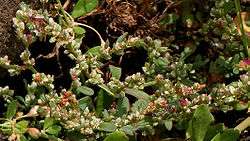Polygonum plebeium
Polygonum plebeium, the common knotweed,[2] is a species of flowering plant in the knotweed family, found natively throughout much of South Asia including India, in Madagascar, and introduced to the United States and Australia. It occurs in disturbed habitats that frequently are flooded, such as banks, ditches, and rice fields. It is used as a vegetable in food in some locations.[1]
| Polygonum plebeium | |
|---|---|
 | |
| Scientific classification | |
| Kingdom: | Plantae |
| Clade: | Tracheophytes |
| Clade: | Angiosperms |
| Clade: | Eudicots |
| Order: | Caryophyllales |
| Family: | Polygonaceae |
| Genus: | Polygonum |
| Species: | P. plebeium |
| Binomial name | |
| Polygonum plebeium R.Br. | |
Native names
Hindi: मचेची Machechi • Meitei: তৰাকমনা Tarakmana • Marathi: गुलाबी गोधडी Gulabi Godhadi • Bengali: Chemti sag • Oriya: Muthisag • Gujarati: Zinako Okhrad • Sanskrit: सर्पाक्षी Sarpakshee at Pocharam lake, Andhra Pradesh, India.
gollark: Oh, I should ask about favourite fundamental particles too.
gollark: By symmetry, it should have "still", I suppose.
gollark: PRs welcome!
gollark: I don't know about coffee.
gollark: <@137565402501742592> Do YOU have question/answer suggestions?
References
- Watve, A. (2011). "Polygonum plebeium". The IUCN Red List of Threatened Species. IUCN. 2011: e.T177128A7373683. doi:10.2305/IUCN.UK.2011-1.RLTS.T177128A7373683.en. Retrieved 15 January 2018.
- "Polygonum plebeium". Natural Resources Conservation Service PLANTS Database. USDA. Retrieved 12 October 2015.
This article is issued from Wikipedia. The text is licensed under Creative Commons - Attribution - Sharealike. Additional terms may apply for the media files.
